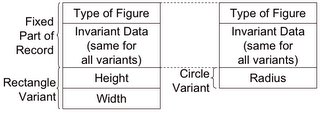We may return to talk more about parsing later.
1. Name forms:
max length, connector characters, case sensitivity, Limitation on max length to ease symbol table. C++ unlimited, but depends on implementation. does case sensitivity hurt readability, reliability, writability?
2. Special words = keywords vs. reserved words.
REAL APPLE
REAL = 3.4
INTEGER REAL
REAL INTEGER
predefined names in Ada. INTEGER and FLOAT are there by default but may be overridden. Pascal. Others in Ada brought in via with statements. printf and scanf in C.
3. Variables
Replace absolute address with symbols. A tuple: (name, address, value, type, scope).
address: can have many instantiations of same name at different addresses. via functions, different scope, recursion. vs.
alias - many names for one address. EQUIVALENCE in Fortran. Pascal and Ada's variant record structure. See here: How do we implement this? Change size of allocate maximum.
How do we implement this? Change size of allocate maximum.
constrained vs. unconstrained.
TYPE Geom_Type IS (Unknown, Rectangle, Circle);
TYPE Geometric_Figure(Figure_Type : Geom_Type := Unknown) IS RECORD
-- Invariant data fields here
CASE Figure_Type IS
WHEN Rectangle =>
Width : Float;
Height : Float;
WHEN Circle =>
Radius : Float;
WHEN Unknown =>
NULL;
END CASE;
END RECORD;
-- An unconstrained Geometric_Figure
GC : Geometric_Figure( Figure_Type => Circle );
-- A constrained Geometric Figure of Figure_Type Circle
discriminant, fixed, variant. reading allowed for all, var so long as proper type. writing: discr if dont change val or as record assignment. record assignment allowed if unconstrained, else discr must match. record compare if discr match/
C's union. C's pointers, C++'s references.
type - defines value range and ops can perform. unsigned short int.
value - contents of mem cell.
4. Binding
Association between attrib and entity, or between op and symbol.
binding time = when binding takes place.
int count; ... count = count + 5;
Bindings and binding times:
set of poss types for count: lang design time
type of count: compile time
poss values for count: compiler design time
count's value: execution time
meanings of +: lang definition time
meaning of + in this statement: compile time
internal representation of 5: compiler design time
binding attribs to vars: static = before runtime. vs. dynamic.
Type Binding. static w/ or w/o explicit declarations. Modern: Perl, ML - no explicit. VB6 optional. Fortran, PL/I, Basic: implicit. we spoke about Fortran's convention, and about unreliability. C: declarations vs definitions. dynamic: not bound by declaration, but at assignment, and can be reassigned. =flexibility. func can deal with data of any type. C++ needs know type of the data. Consider swap in C.
Jscript: list = [1.4, 4.5] and can reassign to a scalar.
lack of reliability due to typos generating new vars, or if assignment should not work, will.
usually interpreted rather than compiled because hard to implement dynamic type changes in machine code.
Type inference: ML can infer type.
fun circum(r) = 3.14 * r * r;
fun square(x) : int = x * x; //int specifies return type
Storage Bindings/Lifetimes
allocation/deallocation. lifetime= time var bound to a specific address.
static vars - throughout program execution. retain history, speed 'cause no alloc/dealloc. no recursion, waste of space.
stack-dynamic - allocated when declaration statement reached. could either be when enter func (Ada) or when reach that pos (Java). Allows recursion, sharing of space.
explicit heap-dynamic - using new and delete
implicit heap-dynamic - Perl, Javascript arrays and strings. as a result of assignment.
No comments:
Post a Comment